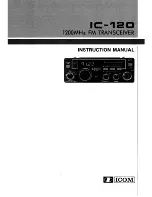
V10/V7.5/V5/V3.5 Installation and Operation Manual
Page
2-1
Section 2 Preparation for Use and Installation
Issue 3.5
V10/V7.5/V5/V3.5
INSTALLATION AND OPERATION MANUAL
Section 2
PREPARATION FOR USE AND INSTALLATION
2.1 INTRODUCTION
This section contains pre-installation and
installation information for the transmitter.
NOTE
Failure to comply with instructions in this
section may void the manufacturer’s
warranty. Please review Nautel’s warranty
terms for more information.
2.2 PREPARATION FOR USE
Prepare the site to receive the transmitter
prior to its delivery and/or installation.
Consider the following when preparing
new sites and use it as the evaluating
criteria at existing sites. Nautel
recommends that you incorporate all
requirements to ensure optimum reliability
and performance.
NOTE
Frequent reference is made to connectors
and terminal blocks on the remote
interface PWB. This PWB is located at the
front of the transmitter behind the silk-
screened front panel.
2.2.1 Transmitter Room
Requirements
Address the following criteria when
finalizing the transmitter site.
2.2.1.1 Transmitter Dimensions
Refer to Figure 2-8 (V10/V7.5) or 2-9
(V5/V3.5) for transmitter dimensions.
Dimensions identify room entry and floor
space requirements and will assist in
determining cable lengths and routing.
2.2.1.2 Transmitter Weight
Refer to Figure 2-1 for transmitter weight.
Sufficient manpower or lifting apparatus is
required to move the transmitter.
2.2.1.3 Transmitter Clearances
Refer to Figure 2-1 for recommended
transmitter clearances, noting that the
V10/V7.5 cabinet is larger than the
V5/V3.5 cabinet.
2.2.1.4 Air Flushing
Fans at the rear of each RF power module
and at the front of each switching power
supply module draw cooling air through a
filter in the rear of the transmitter. Cooling
air exhausts through openings in the front
and top of the transmitter.
Open Ventilation: Air from the RF power
modules exhausts at the top front and air
from the switching power supply modules
exhausts at the bottom of the front door.
An air exchange rate of 1007 CFM (V10),
864 CFM (V7.5), 490 CFM (V5) or 431
CFM (V3.5) achieves acceptable intake/
exhaust temperature rise.
Closed Ventilation: Air is drawn through
the transmitter by first entering via the top
of an extension rack at the rear, then
exhausting through the top of an
extension rack at the front. The static
pressure in the exhaust duct must be
slightly negative. The static pressure at
the rear of the transmitter must be neutral
or slightly positive.
2.2.1.5 Cooling and Heating
Refer to Figure 2-1 for transmitter room
ambient air temperature limitations. Refer
to Table 2-1 for cooling requirements.
Ensure adequate cooling and/or heating
systems are in place to maintain
appropriate ambient air temperature.
Содержание V10
Страница 2: ......
Страница 10: ......
Страница 20: ......
Страница 52: ......
Страница 54: ......
Страница 55: ...Dimensions inches mm Dimensional Information V10 V7 5 Transmitter Issue 3 5 Not to Scale Figure 2 8 Page 2 29 ...
Страница 56: ......
Страница 57: ...Dimensions mm inches Dimensional Information V5 V3 5 Transmitter Issue 3 5 Not to Scale Figure 2 9 Page 2 30 ...
Страница 58: ......
















































